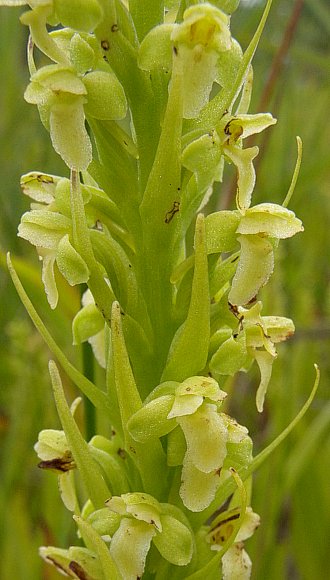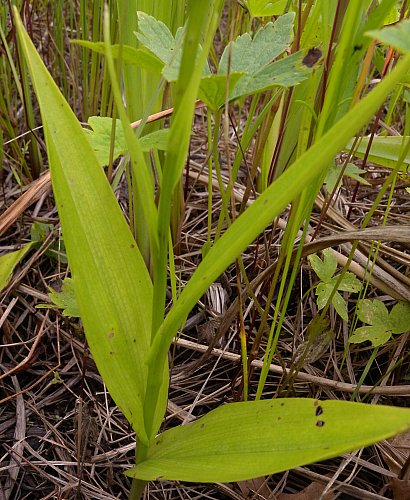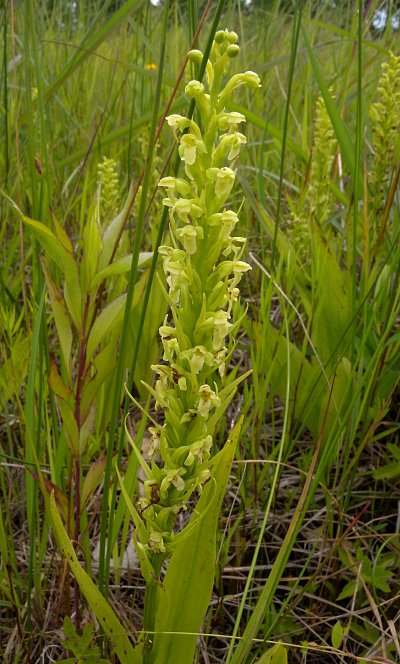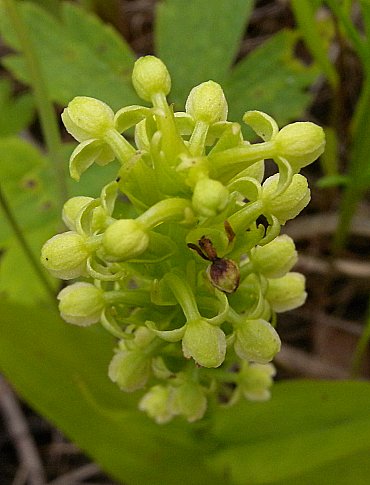 Description:
This herbaceous perennial plant is ¾–2¼' tall and unbranched. The
central stem is light green, glabrous, and relatively stout. Along this
stem, there are 3-5 alternate leaves that are up to 8"
long and 2" across, becoming smaller in size above. The orientation of
the leaf blades is
ascending to strongly ascending, although the lowest ones may be
spreading; they are lanceolate to elliptic in shape and their margins
are entire (toothless). The leaves clasp the stem at their bases, while
their tips are acute and often hull-shaped, rather than flat. Depending
on light
exposure and age, the upper and lower leaf surfaces are light green,
medium green, or yellowish green; they are also glabrous. Leaf venation
is parallel. The central stem terminates in a bracted spike of sessile
flowers about 2-10" long. Individual flowers are about 1/3" (8 mm.)
tall and similarly across (excluding the ovary and nectar spur); they
are predominately whitish green or yellowish green. Each flower
consists of 3 petals, 3 sepals, an inferior ovary, and a small
reproductive column. The three outer sepals are mostly green, sometimes
with narrow whitish margins, and broadly oblong in shape; the upper
sepal
curves forward and functions as a protective hood over the reproductive
column, while the lateral sepals are somewhat recurved. The upper two
petals are whitish or yellowish green and broadly oblong in shape; they
curve forward on either side of the upper sepal, increasing the width
of
the hood. All of these sepals and petals are about the same size (3-4
mm. long). The lowest petal forms the lower lip and a nectar spur. The
lower lip curves forward and downward from the center of the flower; it
is whitish or yellowish green, broadly oblong in shape, and about
4-6 mm. long. The base of the lip has a pair of tiny eared lobes
(auricles) along its margins; the lip also has a small tubercle (or
bump) toward the center near its base. The margin of the lip
is smooth to slightly erose (slightly ragged). Behind the lip of the
flower, there is a slender nectar spur about 3-8 mm. in length. During
the blooming period, the light green ovary is narrowly ellipsoid,
curving outward; it is ascending. At the bases of these
flowers, there are solitary leafy bracts. These bracts are ascending,
greenish, narrowly lanceolate-triangular in shape, slightly
hull-shaped, and up to 1½" long; they are usually longer than the
flowers, especially along
the lower one-half of the floral spike. The blooming period occurs
during early to mid-summer, lasting about 3 weeks. The flowers are
slightly fragrant. Afterwards, fertile flowers are replaced by seedpods
that are about 1/3" (8 mm.) long and ellipsoid-ovoid in shape. These
seedpods eventually break open to release numerous tiny seeds. These
seeds are distributed by the wind. The root system has fleshy fibrous
roots that are sometimes thickened and tuberous, and occasionally
clonal offsets develop. At favorable sites, colonies of plants
occasionally develop.
Description:
This herbaceous perennial plant is ¾–2¼' tall and unbranched. The
central stem is light green, glabrous, and relatively stout. Along this
stem, there are 3-5 alternate leaves that are up to 8"
long and 2" across, becoming smaller in size above. The orientation of
the leaf blades is
ascending to strongly ascending, although the lowest ones may be
spreading; they are lanceolate to elliptic in shape and their margins
are entire (toothless). The leaves clasp the stem at their bases, while
their tips are acute and often hull-shaped, rather than flat. Depending
on light
exposure and age, the upper and lower leaf surfaces are light green,
medium green, or yellowish green; they are also glabrous. Leaf venation
is parallel. The central stem terminates in a bracted spike of sessile
flowers about 2-10" long. Individual flowers are about 1/3" (8 mm.)
tall and similarly across (excluding the ovary and nectar spur); they
are predominately whitish green or yellowish green. Each flower
consists of 3 petals, 3 sepals, an inferior ovary, and a small
reproductive column. The three outer sepals are mostly green, sometimes
with narrow whitish margins, and broadly oblong in shape; the upper
sepal
curves forward and functions as a protective hood over the reproductive
column, while the lateral sepals are somewhat recurved. The upper two
petals are whitish or yellowish green and broadly oblong in shape; they
curve forward on either side of the upper sepal, increasing the width
of
the hood. All of these sepals and petals are about the same size (3-4
mm. long). The lowest petal forms the lower lip and a nectar spur. The
lower lip curves forward and downward from the center of the flower; it
is whitish or yellowish green, broadly oblong in shape, and about
4-6 mm. long. The base of the lip has a pair of tiny eared lobes
(auricles) along its margins; the lip also has a small tubercle (or
bump) toward the center near its base. The margin of the lip
is smooth to slightly erose (slightly ragged). Behind the lip of the
flower, there is a slender nectar spur about 3-8 mm. in length. During
the blooming period, the light green ovary is narrowly ellipsoid,
curving outward; it is ascending. At the bases of these
flowers, there are solitary leafy bracts. These bracts are ascending,
greenish, narrowly lanceolate-triangular in shape, slightly
hull-shaped, and up to 1½" long; they are usually longer than the
flowers, especially along
the lower one-half of the floral spike. The blooming period occurs
during early to mid-summer, lasting about 3 weeks. The flowers are
slightly fragrant. Afterwards, fertile flowers are replaced by seedpods
that are about 1/3" (8 mm.) long and ellipsoid-ovoid in shape. These
seedpods eventually break open to release numerous tiny seeds. These
seeds are distributed by the wind. The root system has fleshy fibrous
roots that are sometimes thickened and tuberous, and occasionally
clonal offsets develop. At favorable sites, colonies of plants
occasionally develop.
Cultivation: The preference is full or partial sun, wet to moist conditions, and sandy or sandy-peaty soil. This orchid is difficult to cultivate, doesn't transplant well, and it is generally unavailable for cultivation. It requires, or at least benefits from, the presence of appropriate mycorrhizal fungi in the soil.
Range & Habitat: This variety of the native Tubercled Orchid is found primarily in northern Illinois, where it is rare and state-listed as 'threatened' (see Distribution Map). The typical variety of this orchid occurs in southern Illinois, where it is rare and state-listed as 'endangered.' Habitats include openings in moist woodlands, wet to moist meadows, wet to moist sand prairies, sandy pannes, low sandy areas along slow-moving or stagnant rivers, margins of interdunal sandy swales, and seeps. This wildflower is found in high quality natural areas.

Faunal Associations: The small greenish flowers of this orchid are cross-pollinated by mosquitoes (Aedes spp.), snout moths (Pyralidae), and possibly other small to medium-sized moths (Luer, 1975; Cingela, 2001; Hapeman, 2008). The floral reward of these insects is nectar. Both the adults and larvae of a weevil, Stethobaris ovata, feed destructively on this orchid and other orchid species. The adults feed on the leaves, buds, and flowers, while the larvae feed within the seedpods (Howden, 1995). Both the foliage and flowers of this orchid are vulnerable to browsing by White-tailed Deer and other mammalian herbivores. Compared to the showier orchids, the Tubercled Orchid is relatively inconspicuous even when it is in bloom, therefore it may not attract such herbivores to the same extent.
Photographic Location: A moist sandy meadow at a state park in NE Illinois.

Comments: The common name of this orchid refers to a small tubercle (or bump) that is found toward the base of the lip of its flower. This is one of the distinctive characteristics that distinguishes the Tubercled Orchid (Platanthera flava) from other similar orchids. Another distinctive characteristic is the presence of 2 tiny auricles (or basal lobes) at the base of the lip of its flower along its margins. There are two varieties of this orchid in Illinois: Platanthera flava flava and Platanthera flava herbiola. Compared to the latter variety that has been described here, the typical variety of this orchid has fewer leaves along its central stem (typically only 2 or 3), shorter bracts that don't extend beyond the flowers, and more widely spaced flowers along its floral spike. Several common names have been used to refer to this orchid – in addition to the Tubercled Orchid, they include the Pale Green Orchid, Tubercled Rein Orchid, and Northern Tubercled Bog Orchid.